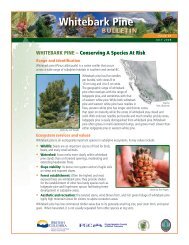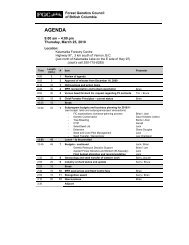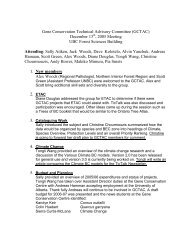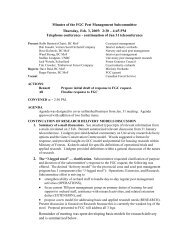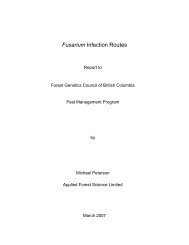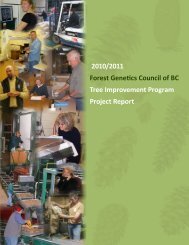Tree Improvement Program Project Report 2006 / 2007
Tree Improvement Program Project Report 2006 / 2007
Tree Improvement Program Project Report 2006 / 2007
Create successful ePaper yourself
Turn your PDF publications into a flip-book with our unique Google optimized e-Paper software.
During this first year, the seed orchard parental<br />
population (53 clones) and the SMP parents were<br />
fingerprinted. Additionally, DNA samples from 1,300 pairs<br />
of megagametopytes (haploid) and their corresponding<br />
embryos (diploid) were extracted from a random sample of<br />
the orchard’s bulk seed, and their fingerprinting is expected<br />
to be completed during the second year.<br />
Two data analyses approaches will be attempted,<br />
one utilizing a computer program that was developed<br />
specifically to handle bulk seed, and the second utilizing a<br />
program developed by Slavov et al., 2005. These analyses<br />
are expected to allow the determination of every clone’s<br />
gametic contribution.<br />
The results will aid in the accurate estimation of the<br />
genetic worth and diversity of the orchard’s seedlot by<br />
relating the DNA results to the visual assessments of<br />
reproductive output. The resulting correlations will be used<br />
to assess the various survey methods and to calibrate survey<br />
methodologies as appropriate.<br />
72<br />
.3 Mounta n P ne Beetle<br />
Incremental <strong>Project</strong>s<br />
.3.1 Pollen Management n<br />
Lodgepole P ne Orchards:<br />
<strong>Project</strong> 0 72 E<br />
George N cholson<br />
Young lodgepole pine orchards produce very little pollen in<br />
the early years. This project was designed to collect pollen<br />
from the older Thompson Okanagan 310 orchard and<br />
reapply it to the young ramets in orchard 339.<br />
The pollen was vacuum collected, and this allowed us to<br />
reapply the pollen in the same season. We collected a total<br />
of 10 litres of pollen and applied three litres to the orchard.<br />
The balance of the pollen was put into freezer storage for<br />
future use.<br />
T R E E I M P R O V E M E N T P R O G R A M<br />
P R O J E C T R E P O R T 2 0 0 6 / 2 0 0 7<br />
.3.2 Effect ve Crown Prun ng<br />
n Lodgepole P ne: <strong>Project</strong><br />
0 7E2<br />
George N cholson<br />
This is a multi-year project designed to stimulate cone<br />
production in the top third of the crown. Both top and<br />
upper lateral branches were pruned.<br />
We used mechanical shears to prune in most cases or a<br />
small chain saw if stem diameter was too large. The level of<br />
pruning in the orchards may reduce the cone production in<br />
the year following, but this effect will not be long lasting.<br />
During the fall of <strong>2006</strong>, a total of 580 ramets were<br />
top and lateral-branch pruned in the mature Thompson<br />
Okanagan 310 orchard. We will top prune a further 1,000<br />
ramets in orchard 339 in <strong>2007</strong> and 1,500 ramets in 2008.<br />
The top pruning in the younger orchard will help control the<br />
ramet height and increase the number of potential cone sites.<br />
.3.3 Upgrad ng of Lodgepole P ne<br />
Super or Provenance Seed:<br />
<strong>Project</strong> 0 7E26<br />
Dave Kolotelo<br />
This project attempted to upgrade the germination of a<br />
lodgepole pine superior provenance (Rocky Mountain<br />
Trench) seed lot (2612 – collected 1972). In the past this<br />
seed lot was approved for disposal for reasons associated<br />
with poor germination (64 percent). It is an atypical seed<br />
lot because its dry (D1) test has consistently performed<br />
better than a stratified (G20) test. An inventory of 96 kg<br />
of seed (equivalent to approximately 5.5 million seedlings)<br />
exists, and we attempted to upgrade the seed lot because of<br />
its size and its expanded range (BSH; EK; MRB; SA; TOD<br />
and WK seed planning zones).<br />
Seed-lot evaluations indicated the presence of<br />
mechanical seed-coat damage, seed-coat chitting, and<br />
heat damage. We used liquid separation of a partially<br />
imbibed product and pre-vac to try and remove this<br />
fraction (referred to as poor). The table following provides<br />
an overview of the processing results. Germination of the<br />
upgraded fraction increased only slightly (67 to 70 percent),



